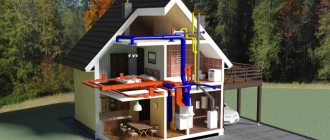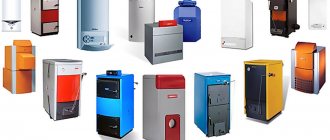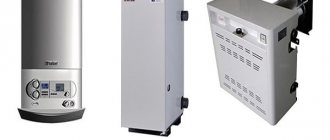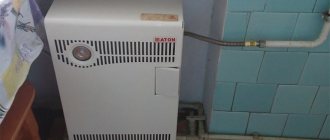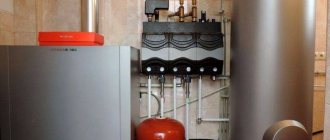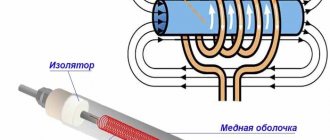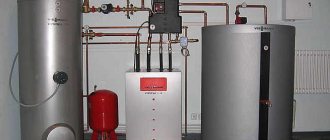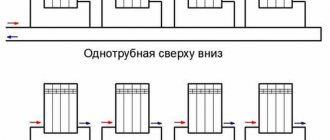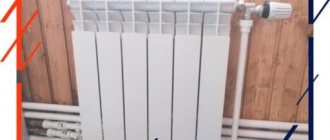Updated: 02/19/2021 18:42:51
Expert: Andrey Nikolaevich Kuznetsov
*Review of the best according to the editors of expertology.ru. About the selection criteria. This material is subjective in nature, does not constitute advertising and does not serve as a purchase guide. Before purchasing, consultation with a specialist is required.
In autonomous heating systems, water circulates through pipes, transferring heat from the boiler to the radiators. It is cheap and effective, but requires regular supervision. If the house is visited periodically in winter or there are long trips on vacation, the system may become unfrozen. In the case of boilers that require an electrical connection, long-term power outages can provoke freezing of pipes and rupture of batteries. To prevent this, coolants with alcohol or oil are used, designed for heating systems in private homes and industrial facilities. They work the same way as antifreeze in cars and do not freeze in subzero temperatures. From the ratings and reviews below you will find out the best products in this category, which will help you make your choice.
Types and properties of heat-carrying liquids
The working fluid of any water system - the coolant - is a liquid that takes a certain amount of energy from the boiler and transfers it through pipes to heating devices - radiators or underfloor heating circuits. Conclusion: the efficiency of heating depends on the physical properties of the liquid mediator - heat capacity, density, fluidity, and so on.
In 95% of private houses, ordinary or treated water is used with a heat capacity of 4.18 kJ/kg•°C (in other units - 1.16 W/kg•°C, 1 kcal/kg•°C), which freezes at a temperature of about zero degrees. The advantages of traditional heating fluid are availability and low price, the main disadvantage is the increase in volume when frozen.
Crystallization of water is accompanied by expansion; cast iron radiators and metal-plastic pipelines are equally destroyed by ice pressure
The ice that forms in the cold literally splits pipes, boiler heat exchangers and radiators. To prevent the destruction of expensive equipment due to defrosting, 3 types of antifreeze made on the basis of polyhydric alcohols are poured into the system:
- Glycerin solution is the oldest type of non-freezing coolant. Pure glycerin is a transparent liquid of high viscosity, the density of the substance is 1261 kg/m³.
- An aqueous solution of ethylene glycol - dihydric alcohol with a density of 1113 kg/m³. The starting liquid is colorless and is inferior in viscosity to glycerin. The substance is toxic, the lethal dose of dissolved glycol when taken orally is about 100 ml.
- The same, based on propylene glycol - a transparent liquid with a density of 1036 kg/m³.
- Compositions based on the natural mineral - bischofite. We will analyze the characteristics and features of this chemical separately (below in the text).
Reference. Any non-freezing heating fluid contains a dye that gives the chemical a distinctive color. Poisonous ethylene glycol is usually colored red or yellow, propylene glycol is green (less often blue). Glycerin antifreeze is given a pink tint or left transparent. This classification is not mandatory and is not always observed.
Anti-freeze products are sold in two forms: ready-made solutions designed for a certain subzero temperature (usually -30 ° C), or concentrates, which the user dilutes with water himself. Let us list the properties of glycol antifreezes that affect the operation of heating networks:
- Low crystallization temperature. Depending on the concentration of polyhydric alcohol in an aqueous solution, the liquid begins to freeze at a temperature of minus 10...40 degrees. The concentrate crystallizes at 65 °C below zero.
- High kinematic viscosity. Example: for water this parameter is 0.01012 cm²/s, for propylene glycol - 0.054 cm²/s, the difference is 5 times.
- Increased fluidity and penetrating ability.
- The heat capacity of non-freezing solutions lies in the range of 0.8...0.9 kcal/kg °C (depending on concentration). On average, this parameter is 15% lower than that of water.
- Aggressiveness towards some metals, such as zinc.
- The substance foams when heated and quickly decomposes when boiling.
Propylene glycol antifreezes are usually painted green, and the prefix “ECO” is added to the marking.
In order for antifreezes to meet operational requirements, manufacturers add additive packages to glycol solutions - corrosion inhibitors and other elements that maintain the stability of the antifreeze and reduce foaming.
What is propylene glycol
This substance is directly related to the class of dihydric alcohols. The reagent is a liquid substance with a barely pronounced odor and taste. In industry, it is obtained through the hydration of propylene oxide at a pressure of 16 megapascals and a temperature range of 160-200 degrees.
The chemical formula of propylene glycol is C3H6(OH)2. It is completely safe to use and does not contain toxic elements. For heating systems, aqueous solutions are used, which are based on this reagent.
Propylene glycol has a related composition to ethylene glycol - C2H4(OH)2. But the latter element is not used for heating residential buildings, as it has a fairly high level of toxicity. Moreover, the chemical formula of both substances has some similarity.
About the pros and cons of glycol antifreeze
The main advantage of artificial coolants based on glycols is the preservation of the liquid phase at subzero temperatures. We list other positive aspects of using antifreeze in closed water heating systems:
- coolants do not contain calcium and magnesium salts, which form scale inside the heat exchangers;
- due to the penetrating ability of glycols, the effect of lubrication of moving parts occurs, ball valves and thermostatic valves do not sour, the fittings last longer;
- the boiling point of antifreeze 103-106 °C delays the moment of vaporization and airing in case of overheating of a solid fuel boiler;
- When the temperature drops below the freezing threshold, glycol solutions turn into a gel mass.
Note. The paragraph about scale implies that the “anti-freeze” is diluted with demineralized distilled water.
When glycol mixtures freeze, they form a slurry that is unable to rupture pipes and heat exchangers.
Let us explain the last 2 points. Ordinary water, often poured into the heating system of country houses, begins to boil at 96-98 ° C, actively releasing steam. If the circulation pump is on the TT boiler supply, the steam phase penetrates the chamber with the impeller, water pumping stops, and the boiler completely overheats. A higher boiling point of antifreeze will delay the moment of the accident.
Unlike water, glycol hardened in the cold does not expand and does not destroy pipe walls. In the event of freezing, the only unit that will suffer is the forced circulation pump. The crystallizing gel will jam the impeller and the motor will burn out.
Unfortunately, there are plenty of disadvantages to non-freezing substances:
- Ethylene glycol is poisonous and requires careful handling and disposal of the solution. Glycerin and polypropylene glycol are harmless.
- The heat capacity of the “anti-freeze” is 15% less. To deliver the required amount of heat to the batteries, the liquid flow will have to be increased.
- The viscosity of antifreeze creates additional hydraulic resistance. You will need a more powerful and expensive circulation pump.
- Good turnover is a double-edged sword. Glycols penetrate through the slightest leaks, from which plain water cannot flow.
- Coolants and additives decompose during operation, losing their frost-resistant properties and forming flakes of sediment. The maximum service life of 1 refill is 5 years, then the heating is flushed and replaced.
- When using antifreeze, many gas boiler manufacturers void the warranty of the purchased product.
Glycol liquids are poorly compatible with electric boilers. Instructions for the use of various antifreezes categorically do not recommend filling systems operating in conjunction with electrolysis heaters with antifreeze. That is, for electrode boilers of the “Galan” type, a special coolant developed by the specified company is needed.
Under rare circumstances, antifreeze can release flammable gas that breaks through the automatic air vent. Example: the heat source is an electric boiler, the heaters are Chinese-made aluminum radiators. Heating glycol causes a complex chemical reaction and gas formation. The fact is demonstrated in the video:
Which radiators are best used with antifreeze?
The material of the heating system elements is closely related to the composition of the coolant used. Before purchasing a specific brand of antifreeze, you should make sure that its composition allows filling batteries made of a certain material. It is important to understand which coolant to choose for aluminum radiators, and which one should be purchased for cast iron ones.
Different types of batteries will react differently to the same antifreeze:
- An aluminum radiator will form an electrolytic pair with brass shut-off valves or copper pipes;
It is better not to install aluminum products
- Cast iron heating radiators for antifreeze will be an ideal choice if, instead of rubber seals, polymer ones are installed between sections;
Cast iron must have plastic seals
- Steel elements are suitable for low pressure systems. However, the number of sections will have to be increased;
- Bimetallic products may contain electrolytic vapors, and therefore it is better not to install them.
Bimetal will not last long
New mineral coolants
We decided to highlight the description of these liquids, since they are made based on the natural mineral - bischofite. The substance is a magnesium salt of hydrochloric acid, the full name is magnesium chloride hexahydrate. The manufacturer declares the following characteristics of the finished antifreeze, designed for a minimum temperature of minus 30 degrees:
- the color of the aqueous solution is light yellow, the density is 1117...1250 kg/m³;
- boiling threshold - 116 °C, freezing point - minus 30 °C;
- specific heat capacity - 0.77 kcal/kg •°С (3.23 kJ/kg•°С);
- thanks to the additives, there is no foaming and no aggressive effect on various seals - silicone, paronite, EPDM and BMS rubber;
- the substance is not toxic;
- In terms of viscosity and fluidity, the drug is very close to glycol chemicals.
Reference. The product appeared on the market after 2010. The price of liquid as of 2022 is about 1 USD. e. per liter of finished coolant (-30 ° C).
Compared to traditional glycol analogues, mineral antifreeze benefits due to its high boiling point, cost and health safety. The negative point is the increased density and low heat capacity, 23% worse than that of water.
The practical use of the coolant has revealed a number of shortcomings, as evidenced by reviews from homeowners:
- The fluidity of the solution is extremely high. There have been cases where antifreeze penetrated through the soldered joint of polypropylene pipes.
- Upon contact with air, the liquid fraction quickly evaporates, leaving a noticeable salt build-up. Similar phenomena are observed in heat exchangers and pipelines where air bubbles have penetrated.
- The substance reacts with bare metal on welds. Stalactites of iron and salt form inside the system, reducing the flow area and clogging the mud traps.
- In case of overheating, antifreeze turns into a liquid of unknown color, as shown in the photo.
User responses about this type of “anti-freeze” can be read on the well-known construction forum: https://www.stroimdom.com.ua/forum/showthread.php?t=157650
Taking into account the experience of users, we do not dare to recommend mineral antifreezes for use in heating systems of private houses. Perhaps over time, manufacturers will eliminate the above problems and the magnesium chloride solution will be able to compete on equal terms with glycols.
Ethylene glycol
It is worth knowing that ethylene glycol is very dangerous, so it should be used with extreme caution. So, if the walls of the system are damaged, the consequences can be very dire. So its use in double-circuit boilers is undesirable. In addition, ethylene glycol is strictly prohibited from being used in cases with open expansion tanks, since if it enters the human body (especially a substance with the third hazard class), it will negatively affect health. Although it is impossible to recognize it by smell due to its absence, there is only a slight sweetish aftertaste. So all this is very dangerous and requires caution.
Today, almost all antifreezes in the world are made based on ethylene glycol. Its cost is approximately 80 rubles per kilogram.
Choosing an “anti-freeze” for heating
Tip number one: buy and fill in antifreeze only in extreme cases - for periodic heating of remote country houses, garages or buildings under construction. Try to use water - regular and distilled, this is the least troublesome option.
When choosing a frost-resistant coolant, follow the following recommendations:
- If your budget is limited, take ethylene glycol from any well-known brand - “Teply Dom”, Dixis, Spektrogen Teplo Coolant, Bautherm, Termo Tactic or “Thermagent”. The cost of the concentrate -65 °C from Dixis is only 1.3 USD. e. (90 rubles) per 1 kg.
- If there is a danger of antifreeze getting into household water (for example, through an indirect heating boiler, double-circuit boiler), or you are very concerned about the environment and safety, buy harmless propylene glycol. But keep in mind: the price of the chemical is higher; a ready-made Dixis solution (minus 30 degrees) will cost 100 rubles (1.45 USD) per kilogram.
- For large heating systems, we recommend using premium class HNT coolant. The liquid is made on the basis of propylene glycol, but it has an increased service life of 15 years.
- Do not buy glycerin solutions at all. Reasons: sedimentation in the system, too high viscosity, tendency to foam, a large number of low-quality products made from technical glycerin.
In the light of the flashlight, tiny white flakes are visible - a sediment of technical glycerin - Electrode boilers require a special liquid, for example, HNT-35. Before use, be sure to consult with a representative of the manufacturer.
- Do not confuse automobile antifreezes with chemicals used in heating systems. Yes, both formulations are glycol-based, but the additive packages are completely different. Engine coolant is not compatible with residential water heating.
- For open and gravity-flow heating systems, it is better to use water, or, in extreme cases, propylene glycol diluted at minus 20 °C.
- If the heating distribution is made with galvanized pipes, there is no point in purchasing glycol mixtures. The substance will deal with zinc, lose the package of additives and quickly degrade.
Clarification. It is not profitable to use frost-resistant liquid for an open heating system. Hot antifreeze will evaporate into the atmosphere through the expansion tank, the antifreeze will have to be constantly topped up, and money will be spent. It is unacceptable to pump in ethylene glycol, since its vapors are toxic.
There is a lot of debate about the harmfulness of ethylene glycol compounds, including on the pages of construction forums. Without denying the harmful effects of the chemical on human health, let us draw attention to a convincing fact.
Homeowners whose closed systems are installed well have been using inexpensive glycol for years without any problems. Let's listen to the expert's opinion in the video:
What to look for when choosing antifreeze
To choose a coolant for a heating system, you should consider all the pros and cons of the solutions offered on the market. It is taken into account that in closed circuits toxic ethylene glycol compounds can be used without great risk if the expansion tank is open and harmless propylene glycol is poured into the circuit.
The construction market offers products from a wide range of manufacturers, and since they are made mainly from high-quality imported raw materials and have approximately the same price and a shelf life of no more than 5 years, it is difficult to give preference to any company.
If manufacturers offer antifreeze liquid at too low a price, you can check the authenticity of the solution using traditional methods: since counterfeits mostly contain an acid base, they use soda to check. If a pinch of soda, poured into a small amount of liquid, enters into a violent chemical reaction with it, then the purchased product is fake; with neutral interaction, the authenticity of the product should not raise doubts.
You can determine a branded product using a hydrometer - a device that measures density; the technique allows you to find out the percentage of water in the product. When taking measurements, the density of the composition should not be less than 1.075 g/cm3; if the value is lower, the liquid is most likely diluted with water.
Rice. 9 Temperature dependence of ethylene glycol on concentration
Instructions for use
If your system previously ran on water, switching to antifreeze will not be easy. Theoretically, radiators with a boiler can be emptied and filled with cold-resistant coolant, but in practice the following will happen:
- due to lower heat capacity, the output of batteries and the efficiency of heating rooms will decrease;
- due to viscosity, the load on the pump will increase, coolant flow will drop, and less heat will reach the radiators;
- antifreeze expands more than water, so the capacity of the old tank will not be enough, the pressure in the network will rise;
- To improve the situation, you will have to increase the temperature on the boiler, which will lead to excessive fuel consumption and increased pressure.
Addition. After filling the liquid, the old connections sealed with flax and paint are guaranteed to flow.
Leaking joints must be repacked, sealing the threads with dry flax or thread with sealant
. In order for heating to function normally using a chemical coolant, you need to calculate in advance or remake the existing system according to the new requirements:
- Select the capacity of the expansion tank at the rate of 15% of the total volume of liquid (water was 10%);
- The pump performance is assumed to be 10% more, and the generated pressure is assumed to be 50% more. Let us explain with an example: if previously there was a unit with a working pressure of 0.4 Bar (4 meters of water column), then use a 0.6 Bar pump for antifreeze.
- In order to operate the boiler in optimal mode and not raise the temperature of the coolant, it is advisable to add 1-3 (depending on power) sections to each battery.
- Pack all joints with dry flax or use high-quality pastes - sealants such as LOCTITE, ABRO or Hermesil.
- When purchasing shut-off and control valves, consult with the seller about the resistance of rubber seals to glycol mixtures.
- Pressure test the system again by filling the pipes and heating equipment with water.
- When starting the boiler unit at negative temperatures, set the minimum power. Cold antifreeze needs to be warmed up slowly.
Advice. The total amount of coolant is easy to calculate - the cross-sectional area of the pipe is multiplied by its length, the capacity of the boiler and radiators is indicated in the product data sheets. Find out how to properly place and connect the expansion tank in our separate publication.
Before pumping in frost-resistant liquid, fill in water and test the pipelines with a pressure exceeding the operating pressure by 25%. The
concentrated coolant must be diluted with water, ideally with distillate. Do not rely on an excessive reserve of frost resistance - the more water you add, the better the heating will work. Recommendations for preparing coolant:
- For heating elements, electric and gas double-circuit heat generators, prepare the mixture at minus 20 degrees. A more concentrated solution may foam upon contact with the heater, and carbon deposits will form on the surface of the heating element.
- In other cases, mix the components at freezing point according to the table below. Proportions are indicated per 100 liters of coolant.
- If there is no distillate, first conduct an experiment - dilute the concentrate in a jar with plain water. If you see a precipitate of white flakes - a product of the decomposition of inhibitors and additives, this water should not be used.
- A similar check is done before mixing antifreeze from two different manufacturers. It is unacceptable to dilute ethylene glycol with propylene composition.
- Prepare the coolant immediately before pouring.
The ratio of concentrate and water is given per 100 liters.
To find out the amount of ingredients for a volume of 150 liters, multiply the given figures by a factor of 1.5. The maximum service life of any non-freezing substance in pipes and heating radiators is 5 years. At the end of the specified period, the liquid is drained, the system is flushed twice and filled with fresh antifreeze.
Finally, about coolants for electrode boilers
Electric water heaters of this type operate on the principle of a “soldier’s boiler” consisting of two blades connected to a 220 volt network. Water simultaneously serves as a coolant and electrolyte; heating occurs due to its conductivity, which depends on the content of magnesium and calcium salts.
This is why electrode boilers do not work with distillate and significantly lose power with under-salted water. According to the passport of the Galan heater, the resistance of the working fluid should be no more than 3200 Ohms per 1 cm.
If you pour regular ethylene glycol into an electrolysis heat generator, the substance will enter into a chemical reaction, foam and lose additives against corrosion and scale formation. The problem can be solved in 2 ways:
- A special antifreeze designed for electrode-type units is purchased. Special additives that resist foaming are dissolved in the working environment.
- A saline solution of the required concentration is prepared, as shown in the video below. Such water will begin to crystallize at a lower temperature, although it cannot be compared with antifreeze in terms of frost resistance.
You should pay attention to the preparation of tap water - pass it through a filter and let it sit for 1-3 days. A good solution is to buy a corrosion inhibitor separately and add it to the coolant for the heating system in advance.
